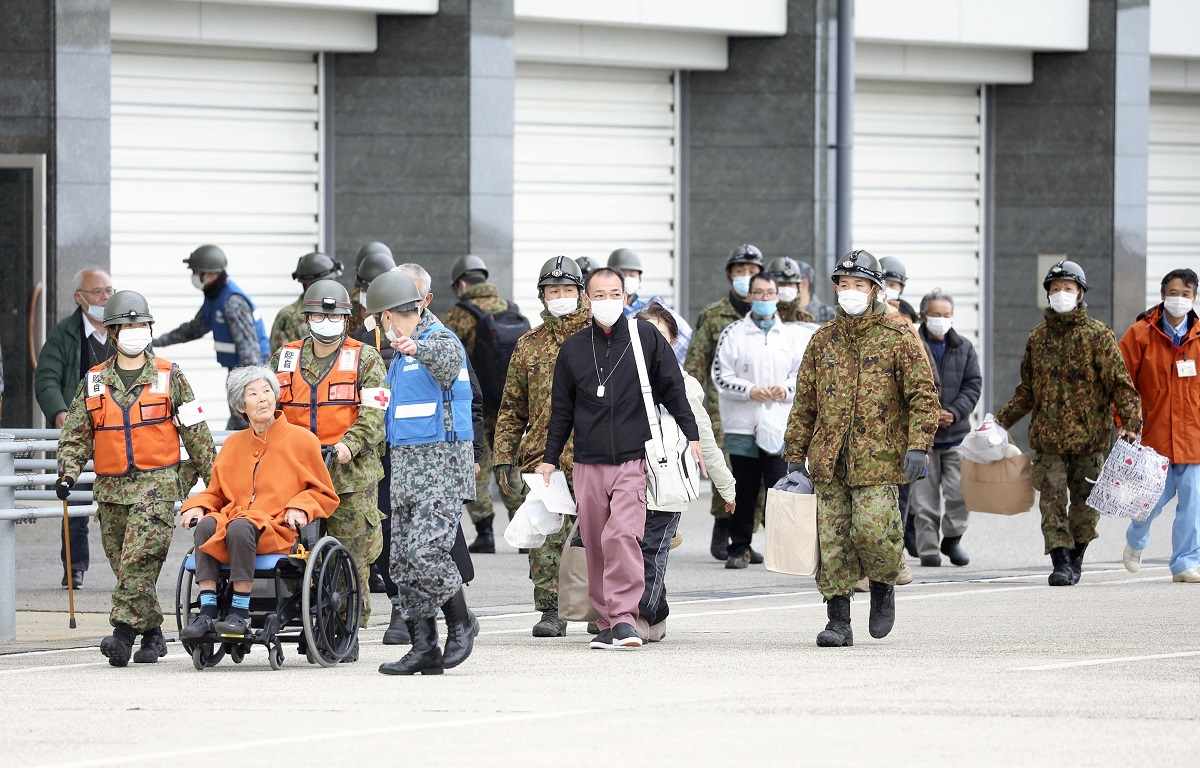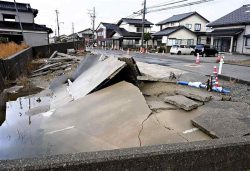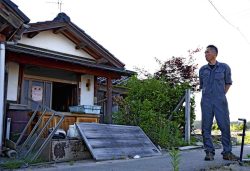Survey Finds Over 80% of Evacuees Hope to Stay in Hometown; Work, Affection for Local Community Most Common Reasons

Evacuees head for a Self-Defense Forces transport aircraft at Noto Airport on Jan. 19.
17:16 JST, January 31, 2024
Many local residents are reluctant to leave quake-hit areas for secondary evacuation centers, according to a survey by The Yomiuri Shimbun on people affected by the Noto Peninsula Earthquake.
The survey was held ahead of the one-month anniversary of the deadly quake, which occurred on New Year’s Day. It also found that many people think it will likely take a long time before they can return to normal life. Some expressed concern that the disaster might accelerate the depopulation of the area.
‘Have to have my ship’
A 74-year-old man engaged in electrical work now stays in a warehouse after his house was damaged in the quake. He is unwilling to move to a secondary evacuation center.
“I can’t make a living without working, and I want to contribute to my hometown, even if it’s just a little,” he said.
The Ishikawa prefectural government is urging evacuees to leave affected areas and use secondary evacuation centers such as hotels and inns for the sake of their health. However, 89 of the people who responded to the Yomiuri Shimbun survey said they had no plans to do so.
Asked why and with multiple answers allowed, the largest number of respondents — 32 — gave their work as the reason.
“I can’t go anywhere, leaving my ship behind. I can’t work without it,” said a 71-year-old fisherman of Wajima City.
Twelve people said they do not want to do so because they are uncertain whether they could return to their hometowns.
“I don’t want to be separated from people I know so well. Even now, joking together is the only thing that makes me feel better,” said Teiji Shimaya, 70, who has lived in the town of Anamizu for many years.
A 39-year-old man from Wajima who did move to a secondary evacuation center had a different opinion. “I was worried about hygiene in the bathroom and shower room. It needs to be improved,” he said.
Asked what worried them, many respondents cited “securing a place to live” and “a prolonged evacuation.”
Affection for local community
More than 80% of the respondents wanted to keep living in their hometowns.
Asked where they would like to live in the future, 86 said “the same place they lived before the disaster” and 24 said somewhere in the same municipality.
As to why, the largest number of 71 cited affection for the place where they have long lived and the people there. Twenty-two people cited their job.
“I can’t imagine going to a place other than my hometown, where I was born and brought up,” said Yoko Hamanaka, 74, a resident of Anamizu whose house was damaged by tsunami. She has strong connections with her local community, as she helped take care of children at an after-school center.
“I want to spend time with children once the center reopens,” she said.
In contrast, Hirokazu Taniguchi, 62, is considering relocating. Taniguchi’s house in the city of Suzu was swept by tsunami.
“I don’t want to have such a terrible experience again,” he said.
Concerns over depopulation
The survey also asked evacuees how long they think it will take for them to return to a normal pre-quake life.
Twenty-nine people answered “from five to 10 years,” followed by 12 who said “more than 10 years,” accounting for about 30% combined. Thirteen people said they don’t think they will ever get back to a normal life.
Another 13 people said “within one year,” while 50 others answered “within five years.”
A 34-year-old beautician from Wajima, chose between five to 10 years, but she worries that young people might leave their hometowns over time.
Areas in the northern Noto Peninsula, which was seriously damaged in the Jan. 1 earthquake, are increasingly depopulated. The population in Wajima declined about 20 percent during the past decade.
“More and more people will leave the city if people in the restaurant, farming and fishing industries find it difficult to make a living because of the earthquake,” said a 39-year-old care worker from the city. “We need to restore the city as soon as possible.”
In Rikuzentakata, Iwate Prefecture, which was battered by the 2011 Great East Japan Earthquake, delays in reconstruction reportedly forced residents to settle in the municipalities they had evacuated to. This contributed to the population outflow from the city.
Yutaka Furutani, head of the Kawarada public center in Wajima, expects it will take longer than 10 years to return to a pre-disaster life, and called for assistance from the central government.
“I want the central government to expedite efforts to present a direction for reconstruction work, to enable younger generations and children to continue living in their hometowns,” said Furutani, 66.
"Society" POPULAR ARTICLE
-

M4.9 Earthquake Hits Tokyo, Neighboring Prefectures
-

M7.5 Earthquake Hits Northern Japan; Tsunami Waves Observed in Hokkaido, Aomori and Iwate Prefectures
-

Tsukiji Market Urges Tourists to Avoid Visiting in Year-End
-

Israeli Tourists Refused Accommodation at Hotel in Japan’s Nagano Pref., Prompting Protest by Israeli Embassy and Probe by Prefecture
-

M5.7 Earthquake Hits Japan’s Kumamoto Pref., Measuring Upper 5 Intensity, No Tsunami Expected
JN ACCESS RANKING
-

Keidanren Chairman Yoshinobu Tsutsui Visits Kashiwazaki-Kariwa Nuclear Power Plant; Inspects New Emergency Safety System
-

Imports of Rare Earths from China Facing Delays, May Be Caused by Deterioration of Japan-China Relations
-

University of Tokyo Professor Discusses Japanese Economic Security in Interview Ahead of Forum
-

Japan Pulls out of Vietnam Nuclear Project, Complicating Hanoi’s Power Plans
-

Govt Aims to Expand NISA Program Lineup, Abolish Age Restriction























